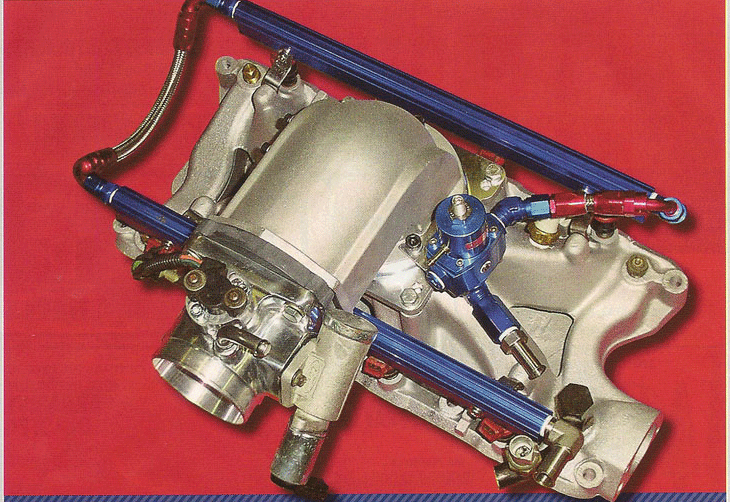
Add Power to Your Engine with Anderson Ford Motorsport EFI Hurricane Intake
MANIFOLD MUSCLE
Story by Wayne Cook • Photos by Anderson Ford Motorsport
The Ford performance experts at Anderson Ford Motorsport have introduced
a new EFI intake manifold for short
deck small-block Ford engines based on the Professional Products Hurricane,
and it’s called the Anderson/EFI Hurricane.
Anderson Ford-Mercury is one of the oldest Ford Dealerships in the United
States and its Anderson Ford Motor- sport (AFM) division specializes
in the creation of performance products for fuel-injected Fordvehicles. They
have a reputation for solid engineering designs which are evaluated by
rigorous testing on both the Super Flow SF1200 flow bench and on the in-house
DynoJet chassis dynamometer. The new EFI Hurricane intake
manifold is intended for use with aftermarket cylinder heads as part of a
serious performance package and is capable of supporting up to 7,500 rpm.
The intake port dimensions at the cylinder head are 1.90x1.08 with enough
materialpresent to enlarge the ports
to 2.10x1.25 if you're handy with a grinder. The manifold features a rear
water crossover passageway along with
four corner-tapped water ports. On top of offering enhanced performance, the
new intake really cleans up the top of your engine for that short-runner
race car look with an EFI elbow. The intake is part number PKAF70213 and costs
$791.98. The complete fuel rail kit consists of the rails,
mounting brackets, crossover connection. AN braided hose assembly, and fuel
pressure regulator and fittings for GE-style
inlet and return lines. The part number for the rail kit is PP-10607 and the
cost is $220.28 (if you have your own manifold to convert).
To evaluate the effectiveness of the new ER Hurricane intake in a real-world
situation, AFM decided to test the manifold on two different
5.01-powered Fox Mustangs—one, a normally aspirated car, while the other
was supercharged. Join us out at AFM
where we'll put both cars on the rollers and see how the new ER Hurricane
compares to a more conventionally
configured long-runner EFI intake manifold in both 'tonally aspirated and
supercharged applications.
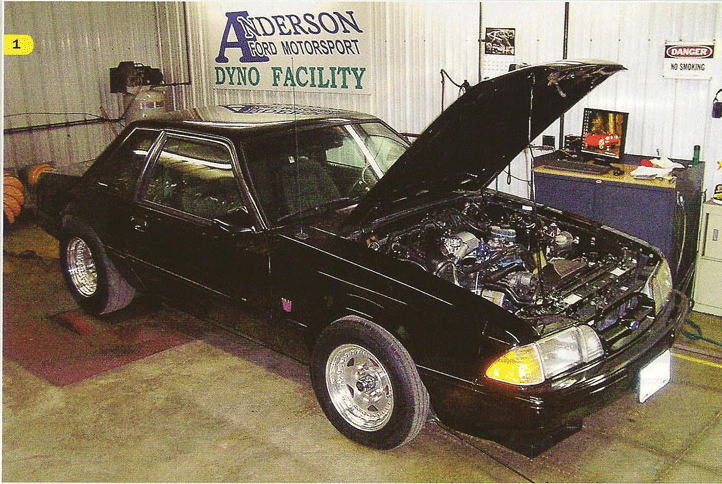
The first car chosen belongs to Brant Obermeyer. His 83 LX coupe is a factory
air conditioning delete car powered by a D55
306ci short block topped with stock Trick Flow heads. Induction hardware included
a Professional Products Typhoon intake manifold set,
a 75mm throttle body, and an 80mm Pro-M mass air meter. The engine is equipped
with an Anderson N-71 Hi-Rev cam and Anderson Power Pipe,
while fuel delivery is accomplished by 30-1b/hr injectors. The ignition system
comes from Mallory. Underneath the car, exhaust equipment includes Bassani
17,
to 13/4-inch long-tube step headers with 21/2-inch exhaust and Bassani mufflers.
The rest of the powertrain includes a 1-5
transmission and an 8.8-inch axle with 4.57 gears. When the car was baselined
at AIM in West Clinton, Illinois,the following results were recorded.
|
RPM
|
HP
|
TQ
|
|
3,200
|
182.73
|
299.92
|
|
3,400
|
193.13
|
298.33
|
|
3,600
|
209.32
|
385.37
|
|
3,800
|
227.61
|
314.58
|
|
4,000
|
241.64
|
317.29
|
|
4,200
|
250.59
|
313.36
|
|
4,400
|
261.32
|
311.32
|
|
4,600
|
277.11
|
316.39
|
|
4,800
|
294.21
|
322.54
|
|
5,000
|
305.35
|
320.75
|
|
5,200
|
314.39
|
317.54
|
|
5,400
|
321.94
|
313.13
|
|
5,600
|
326.05
|
305.80
|
|
5,800
|
328.59
|
297.52
|
|
6,000
|
325.68
|
285.09
|
|
6,200
|
317.60
|
269.05
|
|
6,400
|
307.33
|
252.22
|
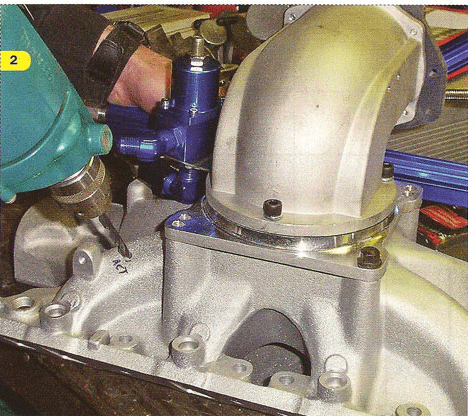
Next, the Hurricane intake installation began. Here, the intake is being
prepared for the ACT (air change temperature) sensor.
Shipping manifolds will not have the ACT sensor hole pre-drilled and tapped
for the customer. This is one step you’ll have to perform yourself.
APO leaves the location up to the end user, though the preferred location
is shown here in the No. 5 intake runner. Once the sensor was installed,
the rest of the Anderson fuel system parts, including the fuel rails, crossover
line, and pressure regulator were fitted using the Mustang's existing injectors.
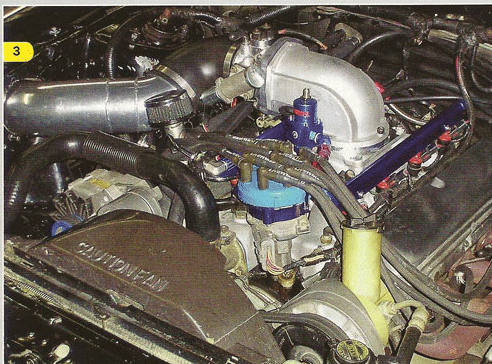
Here's the completed ER Hurricane intake installation. Back on the rollers. Brandt's car recorded the following numbers.
|
RPM |
HP |
TQ |
|
2,800 |
139.62 |
261.88 |
|
3,000 |
157.94 |
276.50 |
|
3,200 |
174.16 |
285.84 |
|
3,400 |
186.45 |
288.01 |
|
3,600 |
198.13 |
289.06 |
|
3,800 |
213.44 |
295.00 |
|
4,000 |
227.41 |
298.59 |
|
4,200 |
240.48 |
300.72 |
|
4,400 |
254.95 |
304.33 |
|
4,600 |
271.96 |
310.50 |
|
4,800 |
290.21 |
317.54 |
|
5,000 |
305.03 |
320.41 |
|
5,200 |
318.57 |
321.77 |
|
5,400 |
331.95 |
323.34 |
|
5,600 |
340.78 |
319.61 |
|
5,800 |
347.32 |
314.51 |
|
6,000 |
354.70 |
310.49 |
|
6,200 |
356.48 |
301.99 |
|
6,400 |
357.82 |
292.98 |
|
6,600 |
354.64 |
282.23 |
|
6,800 |
349.95 |
270.29 |
TO EVALUATE THE EFFECTIVENESS OF THE NEW EFI HURRICANE INTAKE IN A REAL-WORLD
SITUATION, AFM DECIDED TO TEST THE MANIFOLD ON TWO DIFFERENT 5.0L-POWERED
FOX MUSTANGS-ONE, A NORMALLY ASPIRATED CAR, WHILE THE OTHER WAS SUPERCHARGED
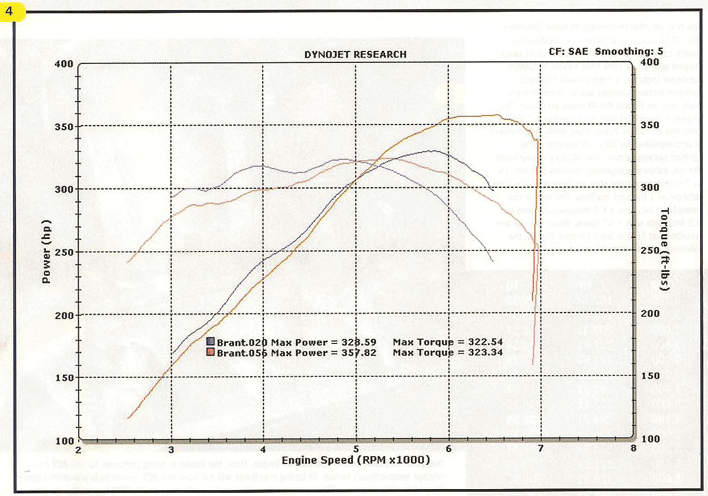
This dyno sheet shows both pulls and graphically illustrates the
horsepower gains.
The EFI Hurricane intake was good for a 29.23 horsepower Improvement.
while the torque factor was up by 0.80 lb/ft. With all else being equal, the
ER Hurricane
intake alone is worth a considerable amount of horsepower.
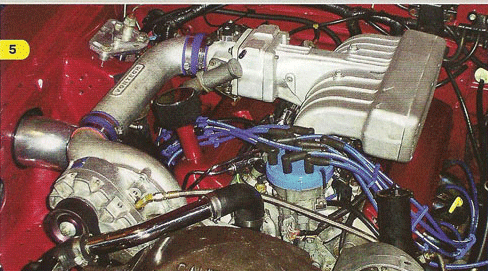
The car selected for the supercharged aspect of the Hurricane intake dyno
test is owned by Chad Kolakowski.
This car is a '93 LK hatch with a stock short-block. This underhood shot of
Chad's car before the EFI Hurricane intake installation
shows the Professional Products Typhoon intake, which was also used to baseline
Thant's car. The engine has an Anderson Stage
II SQ-Trim Supercharger kit. The kit uses a Vortech centrifugal supercharger
creating 14 pounds of boost. Backing up the
blower are a 75mm throttle body and a 90mm mass air meter. Fuel delivery is
achieved with 55lb/hr injectors.
The engine has an Anderson B-31Hr Hi-Rev cam and Mallory ignition. Exhaust
is vented through Bassani shorty headers with
a 21/2-inch cross pipe exhaust system, and 21/2-inch Bassani mufflers. The
rest of the powertrain consists of a T-5 transmission
and an 8.8-inch axle with 3.73 gears. When baselined at Anderson the car put
down the following numbers.
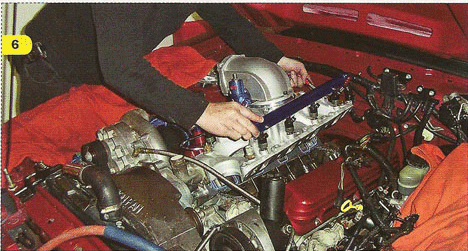
After prepping the CFI Hurricane intake with all of the rails and injectors,
here it's shown going
into place on the supercharged engine. Use Fel-Pro 1250 intake gaskets or
Professional Products 54600 for the installation.
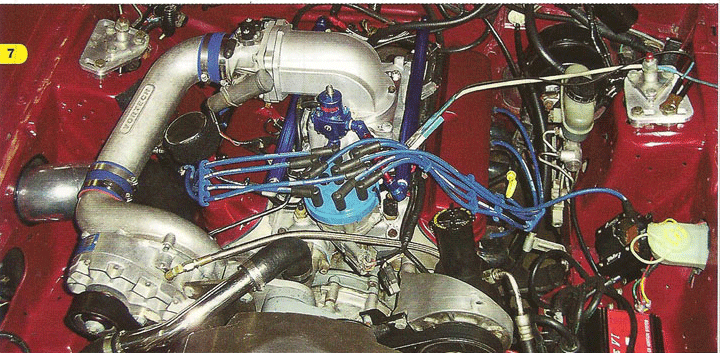
Here's the completed installation of both the EFI Hurricane intake and
the fuel rail kit. This photo shows
what we mean by a cleaned up and all-business look. It screams race car, but
is very much a
streetable bolt-on induction system that connects directly to factory fuel
rails and EFI wiring.
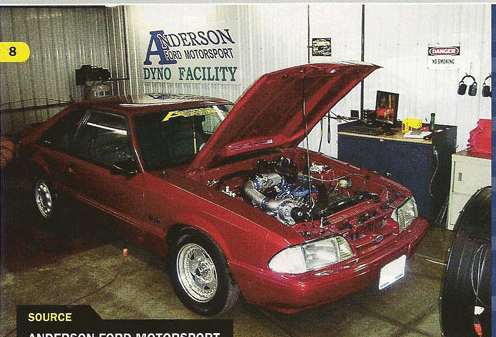
With Chad's car on the dyno and the En Hurricane intake installed, the supercharged engine made the following numbers on the AFM DynoJet.
|
RPM
|
HP
|
TQ
|
|
2,600
|
146.28
|
295.49
|
|
2,800
|
166.35
|
312.03
|
|
3,000
|
182.06
|
318.73
|
|
3,200
|
204.99
|
336.44
|
|
3,400
|
224.40
|
346.64
|
|
3,600
|
252.00
|
367.64
|
|
3,800
|
284.44
|
393.12
|
|
4,000
|
315.53
|
414.31
|
|
4,200
|
344.26
|
430.49
|
|
4,400
|
368.81
|
440.25
|
|
4,600
|
394.40
|
450.30
|
|
4,800
|
419.07
|
458.55
|
|
5,000
|
443.68
|
466.05
|
|
5,200
|
458.91
|
463.51
|
|
5,400
|
471.17
|
458.27
|
|
5,600
|
483.30
|
453.28
|
|
5,800
|
491.49
|
445.08
|
|
6,000
|
504.03
|
437.20
|
|
6,200
|
491.73
|
416.56
|
|
6,400
|
482.19
|
395.71
|
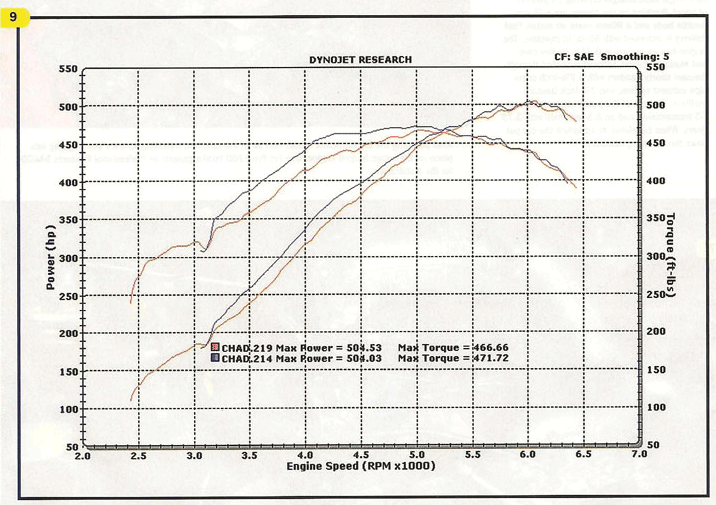
This dyno sheet shows both pulls on Chad's supercharged Mustang. The
car made almost exactly the same
horsepower and torque readings as before the intake manifold exchange. Because
the engine is running
at 14 pounds of boost we weren't too surprised that there was little improvement
as the result of a manifold swap.
On this engine combination we would anticipate the power ratings to closely
follow the boost level and inlet temperatures
and design improvement nuances in the intake manifold that would shine under
normally aspirated circumstances are
over shadowed by the seriously compressed air. The EFI Hurricane intake is
capable of supporting up to 7,500 rpm
and with the peak power coming at 6,000 rpm it seems clear that the intake
manifold was not
the limiting factor on the supercharged application.